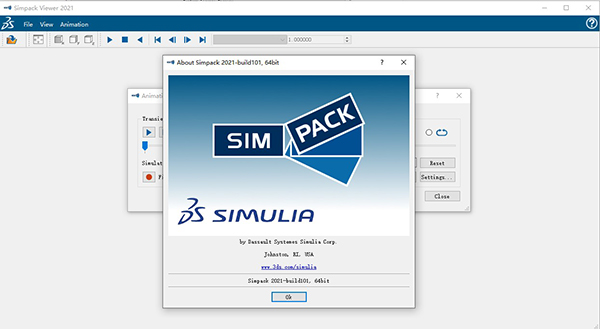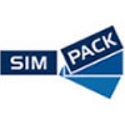
Simpack software introduction
Simpack is used to help engineers fully understand and optimize systems, greatly reducing the need for physical prototyping, shortening product time to market, and improving product quality and service life. Essentially, Simpack gives manufacturers a competitive advantage by providing the ability to create high-quality products in a timely and efficient manner, thereby reducing the overall cost of design, production and maintenance.
The Simpack scripting engine automates the process of creating, studying and modifying models and (re)starting Simpack solvers. Parameter modifications can be made, new dialog boxes can be created, and new model variables can be generated. In addition, the Simpack script engine can be used to control the entire simulation process, including calling external procedures. Includes starting Simpack The entire simulation workflow including Post can be automated and sets of states can be generated after each different solver run. Model information can be accessed from within the simulation.
Simpack software features
1. General functions
HPC/Cloud Computing Support
Win32 is no longer supported
Optional anti-aliasing of result elements
Optionally include the expression directly in the result
Support CGR geometry
Model variant processing
2. Simpack solver
Solver speedup for flexible objects with large numbers of markers
Simpack Post
static maximum energy contour
Usability enhancements for 2D plots
3. Elastomer
Solver’s new support for nonlinear flexible bodies
Manual rigid body mass properties for flexible rigid bodies
Body Strain Contouring in Simpack Post
Reduce the number of input files required to enable flexible body definition
Strain gauge result element
4. Common modeling elements
Revised Weber/Banaschek Contact Recipe
Enhanced polygonal contact model (self-contact and coplanar)
Increased connection friction
5. Simpack engine
Enhance dynamic spring coil contact components with component-specific drawing capabilities
Support for SIMBEAM methods through dynamic spring generation
Optionally include spring guidance during spring generation
6. Simpack Wizard
Variant Creation of Wizard Projects
Various processing improvements
7.Simpack DOE
Enable reordering of factors in experiment creation
8. Simpack Railway
Supports maglev train simulation
9. Simpack Power'By (The role of Simpack expert PXP in 3DEXPERIENCE R2020 simulation)
Improved performance of results export
10. Simpack Multiphysics interface
Supports Matlab version 2018b
Support real-time FMU (for DSpace platform)
Enhanced S-function export to include scripts for modifying the model
Simpack software features
1. DS SIMULIA Simpack 2020 is particularly suitable for high frequency transient analysis, even in the acoustic range. Simpack was originally developed to handle complex nonlinear models with flexible bodies and harsh impact contacts.
2. From initial concept design to production and redesign, Simpack can be used to help engineers fully understand and optimize the system, greatly reducing the need for physical prototyping, shortening product time to market, and improving product quality and service life. Essentially, Simpack gives manufacturers a competitive advantage by providing the ability to create high-quality products in a timely and efficient manner, thereby reducing the overall cost of design, production and maintenance.

3. Diversity and good connectivity with a variety of multiphysics software (such as control, hydraulics and FEA) allow Simpack to be easily integrated into any manufacturer’s already established development process.
4. All functions of Simpack are 100% compatible. Therefore, new software developments targeting a specific engineering field will benefit all Simpack users, regardless of their field of application.
5. As part of the SIMULIA brand, SIMPACK is now a 3D experience portfolio of Dassault Systèmes’ strategic MBS components.
Simpack version features
1. General
Support HPC/cloud computing. Solvers running on HPC/Cloud machines can be launched directly from Simpack
Windows 32-bit systems are no longer supported. Linux 32-bit systems were no longer supported before. Starting from this version, Simpack only supports 64-bit systems.
2. Contact
Moved Marker 96 'Curve-Curve 2D-Contact' supports Primitive6 'Sweep' type geometry
The PCM 199 contact force element supports self-contact. Supports linear flexible bodies and nonlinear SIMBEAM objects, which can be used for simulation of rope models established by nonlinear SIMBEAM.
The PCM 199 force element solves rigid body contact simulations much faster. Enable contact analysis of complex or precise geometric models.
3. Dynamic SpringDynamic Spring
Dynamic springs are mainly used in engine valvetrains and can establish a solid geometric spring model that takes into account the vibration of the spring itself.
Force Element 223 Helical spring contact force element can now display specific curves, including contact conditions for all section types and detailed views of multi-section sections
力元223 螺旋弹簧接触力元支持椭圆类型金属线截面,通过近似为圆形截面处理
Dynamic springs directly generate SIMBEAM definitions. Dynamic spring models of type "SIMBEAM" can now generate models with full SIMBEAM part properties instead of models referencing SIMBEAM generated .fbi files. The main advantage of this change is that it is easy to switch to nonlinear SIMBEAM-based springs. Please note that SIMBEAM type dynamic springs can still optionally be generated in the old way, i.e. by referencing the SIMBEAM generated .fbi file
Dynamic springs are available with inboard and outboard guides. In engine valve train simulations, springs usually have an inner guide and an outer guide. Spring geometry files (smd) implement guidance and define guidance geometry and stiffness/damping information through keywords
All models generated by Dynamic Spring Generator use "New" as the default solver
4. Flexible body based on FE
Supports Nastran CONM1 units and ignores unrecognized Nastran cards
The To mark point of the flexible body joint can define the direction
Forces applied directly to flexible body nodes can now be optionally written to results files and processed in Simpack Viewed in Post, all flexible body types are supported, namely linear and nonlinear SIMBEAM, linear and nonlinear finite element-based flexible bodies, flexible tracks, and joint simulation
For free-floating linear flexible bodies, you can choose to manually set the mass, center of gravity, and inertia tensor. If the mass characteristics are set manually, the effect of mass on deformation is not considered
The name of Result Element 50 was changed from 'Strain Gauge' to 'Flexible Body' Probe'. In addition to strain information, kinematic data and stress data can also be measured
Improved nonlinear flexible body technology is provided. Abaqus software is used to generate nonlinear flexible bodies through modal reduction technology, which has been tested on wind turbine blades. The help document contains tutorials on setting up and using nonlinear flexible blades of wind turbines.
Simpack update log
1. Optimize content
2. The details are more outstanding and the bugs are gone.
Extraction code: gays
Huajun editor recommends:
Simpack is very simple to use. The optimized interface allows you to easily find the functions you want. Come and download it. The editor has also carefully prepared for youFastCAM automatic programming nesting software,Hanwen production planning and scheduling software,Material weight calculation,Green apple weighing software,Machining process quota calculator






































Your comment needs to be reviewed before it can be displayed